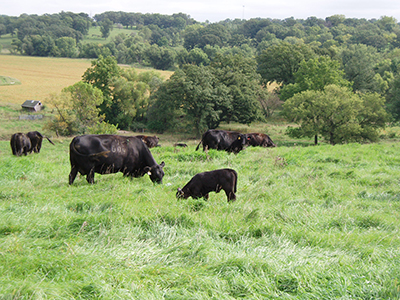Growing Beef Newsletter
July 2024, Volume 15, Issue 1
Tips for stockpiling forages
Dacia Schoulte, Beth Reynolds and Shelby Gruss

After years of significant drought, this spring provided much needed relief to cool season pastures in the Midwest. With many reports of first cutting alfalfa and grass hay yields well over 2023 yields, higher forage yields this spring and lower cow numbers likely left Midwest producers re-evaluating how long the grazing season could be extended and initiated some stockpiling plans to form.
Stockpiling cool season pastures for winter grazing can be as simple as deferring grazing of the paddock being stockpiled, but with some intentional management, yield and quality boosts can be achieved.
Strategies to boost yield/utilization:
- Plan to fertilize. Between July and the end of August, there is an excellent window to apply N fertilizer to grasses for fall growth. By September, it’s typically too late to get a good response to fertilizer applied to cool season pastures in Iowa. Some older data indicates that 40-60 lbs of N applied in early August can boost forage yield by approximately 50%. A study conducted in Wisconsin demonstrated a half ton yield boost in additional forage after applying 60 lbs of N. The greater the legume content in the pasture less additional N needs to be applied to help boost cool-season grass growth.
- Set up fence for strip grazing to improve utilization. Continuous grazing wastes over 50% of available forage due to trampling, so setting up a movable fence is important if optimizing utilization is a priority. Paddocks to rotationally graze is also an option to improve utilization, but since the grazed forage is dormant, strip grazing can simplify labor while achieving utilization goals. Depending on stocking rates, the fence should be moved forward daily or every few days.
Strategies to boost quality:
- Graze or clip before stockpiling. By grazing in the spring or early summer, the regrowth that will be stockpiled will be less mature than forage deferred from grazing the whole growing season. Grazing will remove the lower quality stems and seedheads and promote higher quality, vegetative growth. Do not overgraze, as this will hinder the regrowth response. Around a 4-6 inch height is often recommended. Be sure to stop grazing 60-80+ days prior to a hard frost for adequate growth.
- Not all forages are created equal when it comes to stockpiling. Tall fescue is one of the best at stockpiling with yields and maintaining quality longer. Additionally, stockpiling is an effective strategy to reduce performance drags caused by endophyte infected fescue. Other cool-season grasses like smooth bromegrass and orchardgrass typically loses quality more quickly, making them a poorer choice for stockpiling. However, by knowing what species present, grazing strategies can be applied. For example, grazing smooth bromegrass before tall fescue is one strategy to optimize the forage quality throughout winter. Another common strategy is to defer grazing stockpiled forages until after a killing frost by utilizing crop residue acres first to maximize potential yield and optimize quality characteristics.
A last note to successfully utilize stockpiled pastures, be flexible and prepared, especially when it comes to unruly winter weather. Cattle will continue to graze for high-quality forage in up to 9 inches of snow cover, but anything more or as little as a quarter inch of ice may cause them to stop, especially if previously naive to grazing in those conditions. In this case, feeding supplemental forage is likely needed during those periods. Rain, sleet, and snow can lead to a gradual nutrient loss in stockpiled forages, but it is less loss than many assume. Data from Wisconsin and Canada estimate CP losses around 2-3% points from October to December with protein levels maintained until April. For digestibility, a similar decline through December is expected, with an additional loss of around 5% experienced by April. The nutrient loss experienced differs between species.
Effective grazing management can significantly enhance the quality and yield of forages available for fall and winter grazing. These strategies can help producers extend the grazing season and reduce feed costs in the cold winter months.
This monthly newsletter is free and provides timely information on topics that matter most to Iowa beef producers. You’re welcome to use information and articles from the newsletter - simply credit Iowa Beef Center.
